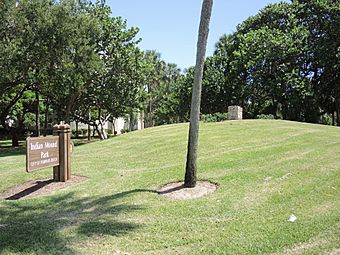Pompano Beach Mound facts for kids
Quick facts for kids |
|
|
Pompano Beach Mound
|
|

Pompano Beach Mound
|
|
| Location | Pompano Beach, Florida |
|---|---|
| Area | less than one acre |
| NRHP reference No. | 14000151 |
| Added to NRHP | 17 April 2014 |
The Pompano Beach Mound is an ancient burial mound in Pompano Beach, Florida. It's found in Broward County, at Indian Mound Park. This oval mound is about 100-foot (30 m) wide and 7-foot (2.1 m) tall. The Tequesta people built it long ago. This special place was added to the National Register of Historic Places on April 17, 2014.
Contents
Where is the Pompano Beach Mound Located?
The mound is located on the southeast side of Pompano Beach. It sits on the western shore of a long, narrow barrier island along the Atlantic coast. Today, the area around the mound is a busy neighborhood with many homes and businesses.
In ancient times, this spot was very different. It was a tropical hardwood hammock. This means it was a forest with strong trees. It was also near Lake Santa Barbara and the mouth of Cypress Creek. Sand dunes and plants protected the eastern side from the ocean.
At the bottom of the mound, there's a layer of "black dirt and shell." This layer is about 6-inch (15 cm) thick. It suggests that people lived or camped here before the mound was built.
Who Built the Pompano Beach Mound?
The Tequesta people built the Pompano Beach Mound. They lived in central and southern Florida. The Tequesta cared deeply for their dead. They would place bodies in a special spot to decompose. Later, they would clean the bones. Then, they would place the bones inside a burial mound.
The Pompano Beach Mound dates back to at least 500 CE. That's over 1,500 years ago! In 1938, a wooden figure was found here. It was made around 700 CE. People called it the "Keeper of the Mound."
This mound is one of 20 to 50 burial mounds built by the Tequesta. It is the only one left in urban Broward County. Other items found nearby suggest a village might have existed here until 1763 CE. Pottery from the site shows it was used during different periods of the Glades culture.
How Has the Mound Been Preserved?
The area around the mound was farmed by James W. Pearce around 1895. He was an early settler in the area. The mound became a park in 1926. This makes it one of Florida's early examples of historic preservation.
Since the late 1950s, it has been a city park for Pompano Beach. It is known as the "Pompano Beach Indian Mound." Many people have studied it since 1929. These include both amateur and professional archeologists.
Items found at the mound are kept in museums. You can see them at the Smithsonian Institution and the Florida Museum of Natural History.
Early Archeological Studies
The first study by a trained archeologist happened in 1937. John Mann Goggin led this work. His findings helped him create a timeline of Florida's ancient cultures. This was very important for his career.
In 1938, the Heye Foundation Museum of the American Indian helped fund a study. William C. Orchard supervised this work. He found several artifacts. These included pottery, a shell cup, and parts of tools. He also found human remains. The city stopped his work after local people objected. In 2010, the National Park Service reported these remains. They will be returned to the Miccosukee Tribe of Indians of Florida. This follows a law called the Native American Graves Protection and Repatriation Act.
More human remains were found in 1940. Some were from approved digs, others from looting. Between 1946 and 1954, Orin Fogle found more items. These included tools made from shells and bones. He also found bones from at least seven people. Fogle sold his collection to the Florida Museum of Natural History.
Recent Discoveries and Protection
In 1958, Pompano Beach celebrated its 50th anniversary. The mound was rededicated as a park for historical preservation. Two historical markers were placed there. It was also named a rare bird sanctuary.
Archeologist Robert S. Carr surveyed the site in 1974. He noticed a second, smaller mound nearby. When he returned in 1993, the smaller mound was gone. Homes had been built over it. In 2003, Christopher Eck surveyed the site. He did small digs to see how replanting native plants might affect the mound.
The first time the mound was written about might have been in 1887. This was in a book called The East Coast of Florida: A Descriptive Narrative. It was written by J.M. Hawks. The mound was officially added to the National Register of Historic Places in 2014.



